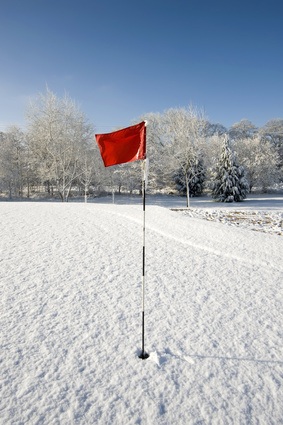
There are a number of factors to consider when playing in colder weather:
1. Heaver cold weather clothing can reduce freedom of motion and reduce your golf swing speed. Additionally, your body and muscles are less flexible in cool weather, so take this into account when making your club selection. It's a good idea to start your cold-weather game playing conservative until your body warms and adjusts to the weather. If you're experiencing reduced flexibility, it's best to use a shorter back swing rather than a longer full swing that requires more flexibility.
2. Low compression golf balls will perform better in cold weather as they help offset the hardening factor caused by lower temperatures.
3. The air temperature changes the compression of the golf ball, and also how it flies through the air. If you're playing golf in 50 degree weather, you will notice about a 10-yard decrease in carry distance compared to play in 80 degree temperatures. Remember this decreased yardage, because it translates to about a 1 or 2 club difference when selecting your golf club.
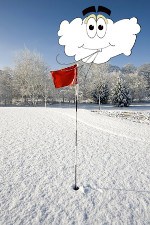
Playing Conditions – Cold Weather Play
For golfers in many parts of the world, playing in cold weather is just part of the deal. Unless you want to take several months off away from the game, you will need to learn how to play when the temperatures start to drop. Fortunately, it is possible to have a ton of fun on the golf course, even if the weather is a bit chilly. Learning how to play your best in cold weather is going to enhance your experience as a golfer, and it will open up your calendar to many new days where you can consider making a tee time.
In this article, we are going to discuss how to enjoy your time on the course during cold weather. Of course, enjoying your time usually means playing well, so much of our advice is going to be based on performing at the highest possible level while dealing with the cold at the same time. There is nothing particularly complicated about playing well in the cold – it just comes down to understanding the conditions, accepting them, and adapting to the best of your ability.
So what exactly qualifies as 'cold weather golf'? There really can't be a specific temperature applied to this term, because what feels cold to one person might feel downright balmy to another. Cold is a relative term, based on the weather you are used to experiencing. For example, if you live and golf in the desert around Palm Springs, CA, a 60-degree day could feel awfully cold when you are used to temperatures of 90*+. On the other hand, someone who lives in a mountainous area in the north could feel like 60-degree weather is cause for shorts and a celebration. It doesn't really matter what the specific temperature is, but rather what matters is how that temperature makes you feel. If you feel like it is a cold day, then it is a cold day – it's just that simple.
If you are thinking about playing golf in cold weather on a particular day, one thing you should always do before heading out is contact the golf course to make sure they are open. If it is really cold, the course may be closed due to frost on the greens. Most courses will not allow you to play when frost is on the greens, as walking on the grass at this time could do serious damage to the course. To save yourself a wasted trip to the course only to find out that they are closed, make a quick phone call and get an update from someone in the pro shop.
All of the content below is based on a right-handed golfer. If you happen to play left-handed, please take a moment to reverse the directions as necessary.
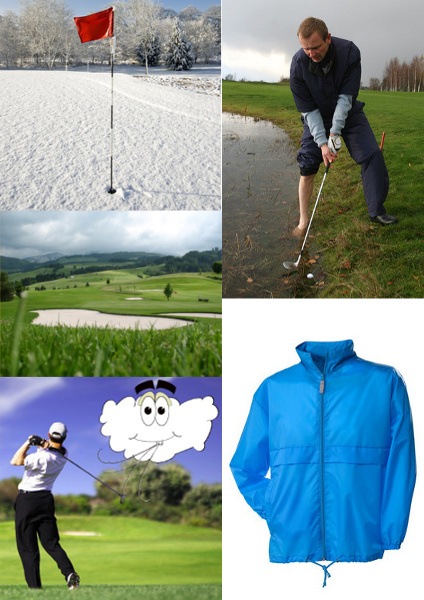
Getting Geared Up
The first key to playing well in cold weather is having the right gear on hand for the job. You don't need to invest thousands of dollars in equipment just to play some golf in the cold, but you do want to consider having a few key items available. As you can imagine, just wandering out to the first tee in a short-sleeved golf shirt and some shorts really isn't going to get the job done when the temperatures are plunging.
Please review the list below to gain a better understanding of the various equipment you can use to get the most out of your time on a cold golf course.
- A lightweight jacket. The challenge you will face when it comes to dressing yourself for a cold round of golf is found in the fact that you need to maintain flexibility while still keeping yourself warm. You are going to want to use lightweight layers to strike the right balance, as something like a big winter coat just isn't going to let you swing comfortably. Many golfers find success with fleece products, as they tend to be warm but not very heavy or restricting. Plenty of golf companies offer jackets which have been specifically designed with the golfer in mind, so check these out online or in your local golf shop. Even if the weather isn't cold enough to need your jacket when you get started, stash it away in your bag for possible use later on.
- A stocking cap or beanie. No matter what you happen to call this kind of hat, it is one of the best things you can have available when golfing in cold weather. Many of the golf apparel companies offer up their own stocking caps, or you can simply buy one from a non-golf retailer. Either way, having a warm cap to pull down over your head – and hopefully, over your ears – will go a long way toward keeping your warm on the links. One of the great things about adding this item to your collection is the fact that it takes up almost no space in your bag, and adds almost no weight. Store it away in a side pocket and know that it will be there when you need it.
- A pair of gloves. You are not going to actually hit shots with these gloves on, but you can wear them in between shots to keep your hands warm. One of the big challenges you will face when playing golf in cold weather is simply maintaining your feel for the golf club all day long. By warming your hands back up between shots, you can keep the blood flowing and improve the way the club feels as you swing. Try to find some fleece mittens for this purpose, as they will be easier to slide on and off than gloves with individual fingers. You can store your pair of gloves right next to your stocking cap to make sure you are prepared when the weather suddenly turns cold.
- Extra socks. This is an easy point to fulfill, as you probably have plenty of extra socks sitting in a drawer somewhere at home. Cold weather is often accompanied by damp conditions, which is why you will want to have extra socks available to change partway through your round. If you notice that your feet are becoming damp and cold, take a moment to switch your socks to a fresh pair. This will help you feel more comfortable as you play, and you should perform better as a result.
- Hand warmers. Many golf shops stock disposable hand warmers that you can slide into your pocket and keep there throughout the day. Once you open these small packets, they heat up due to a chemical reaction. Most of them stay warm for a considerable amount of time, so these can serve as an alternative – or an addition – to the idea of using a pair of gloves to maintain feel in your hands. Although these are disposal items, meaning you will have to purchase more each time you use them, they are quite affordable and usually easy to find in golf shops when the weather is chilly.
As you can see, it isn't going to be necessary to spend a fortune in order to outfit yourself for cold weather. You may choose to add an item or two to the list above, but these points should get you started quite nicely. Once you have the right equipment in your bag or on your body, you can move on to thinking about how your game will need to adapt during cold times of year.

Adjusting Your Swing Technique
You aren't going to need to make dramatic changes to your swing in order to play well on a cold day, but you will want to do at least a couple things differently. Do your best to give yourself time before the round to warm up on the range when playing in the cold, as this will help for a couple of reasons. First, you will be able to warm up your muscles, which is obviously an important task in this kind of weather. Also, you will be able to get comfortable with the swing you are going to use for the day. Since you will be adjusting your swing slightly, the balls you hit on the range can go a long way toward helping you perform well right from the very first shot of the round.
Review the points below for ideas on how you can tweak your game in cold conditions.
- Make a shorter swing. This might be a pretty obvious adjustment, but you are going to want to tighten things up a bit when you are facing cold weather. Simply shorten up everything about your swing, and stay as controlled as possible going back and through. In addition to the limitations that you will face by wearing more clothing, you will also potentially be dealing with poor footing thanks to the weather – so shortening up your swing will make sense on a number of fronts.
- Move the ball back in your stance. This is another adjustment which is meant to simplify your game overall. By moving the ball back a couple of inches on each club, you will be able to make a stable swing while still achieving solid contact. Your normal ball position probably requires a dynamic move in the downswing, and you just might not be capable of making that kind of move given the weather conditions. Sure, your ball flight will be a little bit lower now that you have moved the ball back, but that's okay. Given the cold weather, it is likely you are playing on a soft golf course anyway, so soft conditions shouldn't be much of a problem.
- Narrow your stance slightly. You can think of this as an adjustment which will help you shorten your swing automatically. When you play from a narrower stance, the natural reaction is to shorten up your move in order to stay on balance. You don't want to dramatically narrow your stance, as even moving your feet in just a single inch can help achieve the desired effect. As you are getting ready to start your round, hit a few balls with a narrower stance so you can get comfortable before heading to the first tee.
Again, there shouldn't be anything significantly different about your swing in cold weather. The best option you have is to just make the subtle adjustments listed above, while trying your best to stay in a good rhythm throughout the day. Tempo is crucial in golf regardless of air temperature, so always focus on making a smooth swing and trust your preparation to serve you well while on the course.
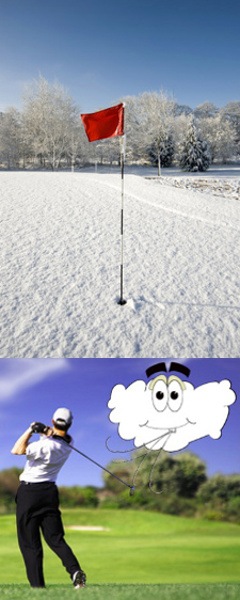
Altering Your Game Plan
The game plan you use to get your ball around the golf course is more important than the changes you make to your swing. Playing golf in cold weather is a different challenge from playing in the summer heat – so you will have to approach the game differently if you want to achieve positive results. While all golfers use their own style of play to get from the first tee to the last green, there are some general guidelines which apply to all players. Review the list of cold weather course management tips below to make sure you are giving yourself the best possible chance at a low score.
- Play to safer targets. There is no way around the fact that you aren't going to be able to control your golf ball as well in cold weather as you can when the temperatures are higher. Without as much feel in your hands and fingers, it will be difficult to make your best swing – and the results are going to speak for themselves. That doesn't mean you are destined to play terrible golf, but it does mean that you should be playing to safer targets than you would normally. Aim toward the middle of most of the greens, and use extra caution when there is a hazard in play. It takes patience to play this kind of golf, but that patience is going to be rewarded with a lower score than if you had stuck with your aggressive approach.
- Use more club. The ball is not going to travel as far in cold weather, so you need to adjust your yardages and use more club on most of your shots. Your shorter swing is going to contribute to this loss of distance, as will simple physics. In most situations, one extra club will do the trick, but you might even need to reach for two extra clubs if you are playing on a particularly cold day. After you gain some experience with cold weather golf you will have a pretty good feel for how to pick the right club based on the combination of weather and yardage that you face.
- Hit driver more frequently. Usually, when you are reading tips about how to manage your way around the golf course, you will find advice that says you should club down off the tee. That is a good bet when the weather is warm, but it is a bad idea in cold conditions. For one thing, your driver is the club with the ability to hit the ball the farthest, and you aren't exactly in a position to be turning down distance when it's cold. Also, the biggest sweet spot in your bag can be found on the driver, and that is a bit of forgiveness that you should be taking advantage of in this situation. Use your driver as often as you can off the tee when the weather is cold and you will make life easier on yourself as the round moves along.
- Give more respect to bad lies. When you have a bad lie in the summer, you might be able to make an aggressive swing and force the ball out of the grass and up toward the green. However, that plan is unlikely to work in the cold. It is hard to make an aggressive swing when you are cold and tight, and the ground will be less forgiving as well. When you do draw a bad lie, take the conservative route and play the ball back to the fairway as quickly as you can. This method will help to keep big numbers off your scorecard, meaning you can stay on track for a successful day overall.
It is always difficult to adjust your game plan to changing conditions, as you are comfortable and confident in the plan you typically use. With that said, adapting to changing conditions is important in golf because it will take a difficult game and make it just a bit easier. Carefully think through all decisions you make when golfing in cold weather, and only proceed with a shot when you are sure that it is the right call.
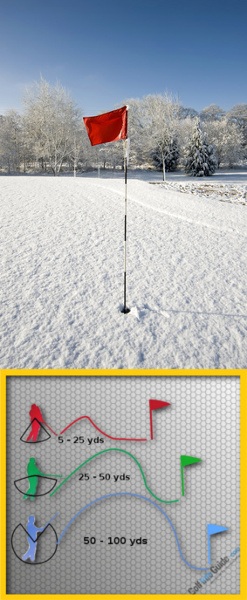
Cold Weather and the Short Game
The cold weather is going to cause some minor problems with your long game, but it is likely to do even more damage to your short game. The shots you play on and around the greens – putts, chips, pitches, etc. – are feel shots, and you won't have much feel in your hands and the temperatures keep dropping. It takes a combination of skill, practice, and smart decision making to perform well in the short game under these circumstances.
To help you play as well as possible on and around the greens in cold conditions, we have listed a few tips below.
- Keep your hands warm until it is your turn to play. This is a critical point to keep in mind. If you have your hands out of your pockets (or gloves) while holding onto your club and waiting for others to play, you are going to lose feel quickly. As others are hitting their shots, either keep your hands in your pockets or put your gloves on. While this seems like a subtle step, it can help you find the touch you need to control your shot. Get into this habit right from the start of your round to make sure the feel in your hands is available when you need it.
- Play the ball low to the ground. It requires more touch to hit a chip or pitch shot high in the air than it does to keep the ball along the ground – and as we have already mentioned, touch is something that may be in short supply during a cold round. Plan on using mostly bump-and-run style short game shots whenever possible in order to improve your chances of success. You may have to play the ball up into the air from time to time, but always opt for the lower shot when you can.
- Don't take anything for granted. You might be able to simply walk up and knock in a three-footer during the summer, but you probably won't have quite as much skill in this area when you are cold. Don't take any of your short game shots for granted in these conditions, no matter how easy they may seem on the surface. Pay attention to each shot, give it your best effort, and always have a game plan in mind. You aren't going to succeed each and every time, of course, but you should be able to come out in good shape more times than not if you simply give a full effort.
Playing golf in the cold can actually be a lot of fun. Is it ever going to be as enjoyable as playing on a warm summer day? Well – probably not, at least not for most people. That doesn't mean you need to put your clubs away when winter rolls around, however. As long as the courses are open, there is golf to be played. Prepare yourself with a few basic winter golf supplies, have a smart game plan in mind, and understand that you won't quite play as well as you do in the summer season. Good luck!






